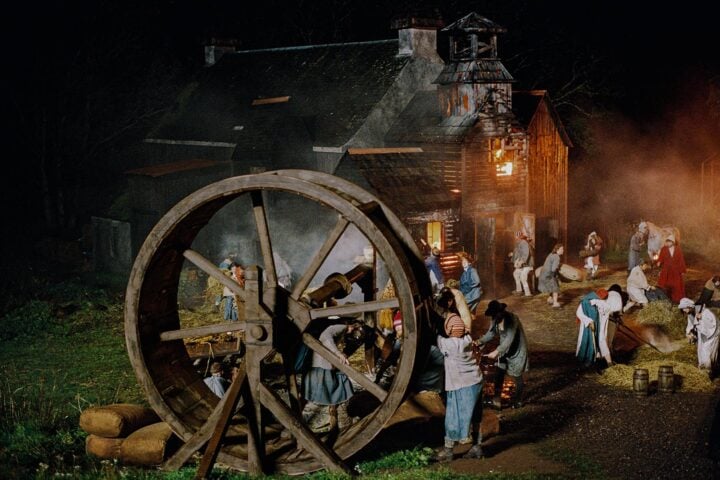Every generation deserves a version of Michael Powell’s Peeping Tom to call its own, including and especially one for which there are few aspects of life that can’t be mediated by screens. Indeed, it’s overwhelming just how many ways there are to watch another human being in 2024, many of which don’t necessitate them watching back. Web streams, security feeds, social media–all glimpses into the private lives of others, each with subtly distinct social functions, facilitating both exhibitionism and voyeurism as a matter of daily routine.
It’s around this tension that writer-director Yeo Siew Hua’s Stranger Eyes coalesces. To describe the film as a surveillance thriller wouldn’t quite be accurate, inasmuch as that term conjures images of shady government figures hunched over chunky laptops, scrutinizing an unsuspecting public. Though there is certainly a bit of that, especially in the beginning, when Stranger Eyes seems to possess the general contours of an Alan Pakula-esque nail-biter.
It opens with its own version of a Zapruder film, a handheld video of a woman playing cheerfully in the park with her daughter (and, conspicuously, wearing a shirt displaying an anime girl’s narrowed eyes with the text “I’M WATCHING YOU” underneath—a bit of a groaner that nevertheless looks cool and is pretty funny). We soon find out that the daughter, Little Bo, has disappeared, with this video seemingly being the most recent footage her young parents Junyang (Wu Chien-ho) and Peiying (Anicca Panna) have of her.
When DVDs containing footage of Junyang, Peiying, and the missing Bo begin showing up, Caché-style, on the family’s doorstep, some quick-and-dirty policing (involving surveillance, naturally) leads them to the taciturn, almost nondescript Wu (Lee Kang-sheng). This development, shockingly matter of fact, occurs within the first half hour of Stranger Eyes, leaving plenty of time for the rest of the film to knot itself into something less familiar. Its characters eventually become ensnared in a circuitous daisy chain of amateur espionage, prompting questions and revelations about who should really be watching who.
Yeo and cinematographer Hideho Urata, who also shot Yeo’s A Land Imagined, have proven themselves adept at capturing distinctly modern digital textures. A Land Imagined, which at one point employs glitching 3D geometry from the video game Counter Strike as a visual interpretation of land reclamation, was perhaps more ambitious in this regard, though this film finds its own groove in the slick coolness of the Singaporean cityscape. The sterility of its world is reflected in the sterility of its screens: text messages cascading like dominoes, CCTV monitors rendering their surroundings in fuzzy silver-white. Characters, meanwhile, stare at them with only traces of detached expression, patiently awaiting an epiphany that may never come.
None are as striking as Wu. In his years collaborating with Tsai Ming-liang—in part due to what Tsai’s work requires, in part due to Lee’s natural presence as a performer—Lee Kang-sheng has attained mastery over a very specific type of cryptic longing, placid on the surface but faintly troubled and never fully anchored to his surroundings. He’s nearly as mute in Stranger Eyes as he is in Tsai’s Days, though as always, he speaks with his eyes, his glances suggesting (and occasionally confirming) an awareness of something nobody else can see.
This performance is the emotional and physical lodestone of a film about the fraught ambiguities of seeing through a one-way mirror. Even as its details come into sharper focus, Lee remains enigmatic, deftly navigating the narrow crawlspace between obsession and curiosity, lust and sympathy—sometimes without moving a muscle. In his own way, he functions as a perfect microcosm of contemporary digital voyeurism: a plainly unsettling, maladjusted person for whom you still develop a profound fondness. You couldn’t look away from him if you tried.
Unfortunately, the film can’t quite sustain the weight of its inventive structure, culminating in some fairly rote conclusions vis-à-vis love and connection in the digital age. Between Stranger Eyes and A Land Imagined, Yeo has a tendency to stage elaborate setups around comparatively straightforward concepts. This film in particular feels as though it wants to go much further—on governmental overreach, punitive justice, fractured identities, sex by way of screens—but it can’t seem to conceive of many uses for these ideas beyond suggestion. The notes it ultimately hits, even with an unexpected and emotional final sting, are frustratingly predictable.
Still, the road there is windy and dense with intrigue, especially in moments contextualized as character studies of Wu, without whom the film has little to fall back on. It’s a testament to the tremendous subtlety of Lee’s acting that it only becomes obvious in retrospect how much of Stranger Eyes is about him, and how much its world bends and refracts around his presence. By that same token, it’s a testament to Yeo’s directing that the film, on a moment-to-moment basis, is as absorbing as it is, given how much of it is people standing around quietly. Its austere rhythm, punctuated with an eerie score and some elegant POV camerawork, impressively leaves little room for downtime in a story defined by it. Watching, fittingly, is a pleasure unto itself.
Since 2001, we've brought you uncompromising, candid takes on the world of film, music, television, video games, theater, and more. Independently owned and operated publications like Slant have been hit hard in recent years, but we’re committed to keeping our content free and accessible—meaning no paywalls or fees.
If you like what we do, please consider subscribing to our Patreon or making a donation.




